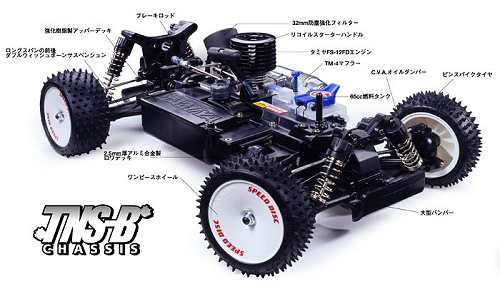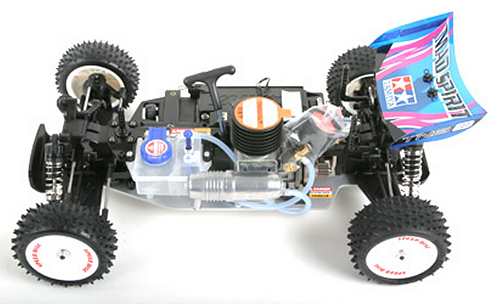

|
|
|


|
Tamiya Mad Spirit - # 43529 (Radio Controlled Model Review)1/10 Scale Nitro Buggy: TNS-B Chassis
Released by Tamiya on December 23, 2006, the 4WD XBG Mad Spirit Buggy (# 43529) is No.29 in the Expert Build Factory Assembled Glow-Engine RC Car Series and was based on the TNS-B chassis, with an FS-12FD engine.
▼ Scroll Down for More Images ▼
Rating: 4
|








|
|
|

|


Buying a Used Tamiya Mad Spirit Buggy (and What to look for)
Make a General Visual Inspection
Check the Body-Shell
If the body shell of your Tamiya Mad Spirit is broken, ripped or damaged in any way, this can be easily repaired with rubber solution glue. Also, for added protection and if available for your Mad Spirit model, fit an under guard to stop dirt and gravel entering the chassis. Drive Shafts and Turnbuckles
Examine the Drive System
The gearbox of your used Buggy should be opened up to check for gear wear and lubrication. A thin coat of grease is often used on internal gears and although this is fine for basic running around on the back yard, if you intend to race your Buggy at a higher level, this should be removed and replaced with racing oil (ZX1 or Teflon Oil). Of course, this should be reapplied after each race meeting. Pinions and Spur Gears
Don't Neglect the Ball-Joints
Ball joints always cause problems. For top level Nitro Buggy racing, the plastic ball connectors should be checked and if deemed necessary changed after every meeting. A simple thing like a loose fitting connector popping off could easily end your race, so better safe than sorry. Steering Servo and Servo-Saver
Stabilizers
If body roll on your Tamiya Mad Spirit is a problem, handling can be improved with the use of stabilizers, anti roll or sway bars, stiffer tuning springs and, or, thicker silicone oil in the dampers. Don't Forget those Bearings
▼ Scroll Down for More Articles and Advice ▼
Or, check out our RC Model Car Setup Guide
|









|






|
|
|
|
Hints, Tips and Information
Keeping Notes
If all you will ever do is go racing at your local track every week, then this article is not for you. However, if you ever look towards travelling around to different tracks around the country, or even the world, the value of keeping notes is all too obvious.
|
|
Hints, Tips and Information
Glow Plugs for Nitro Engines
Nitro Engines for RC Models use a system to ignite the fuel mixture that simply employs a wire coil in a small housing called a Glow Plug. To start the engine, a battery powered Starter, or Glow Igniter, is connected to the Glow Plug and electric current heats the coil to white hot, so that when you pull start your engine, the air - fuel mixture in the cylinder is ignited. With the engine now running, the starter is no longer required. Heat generated under compression is enough to keep the coil element hot enough to keep the engine running.
|
|
RC Models:
|
Radio & Motors: |
Other
Accessories: |